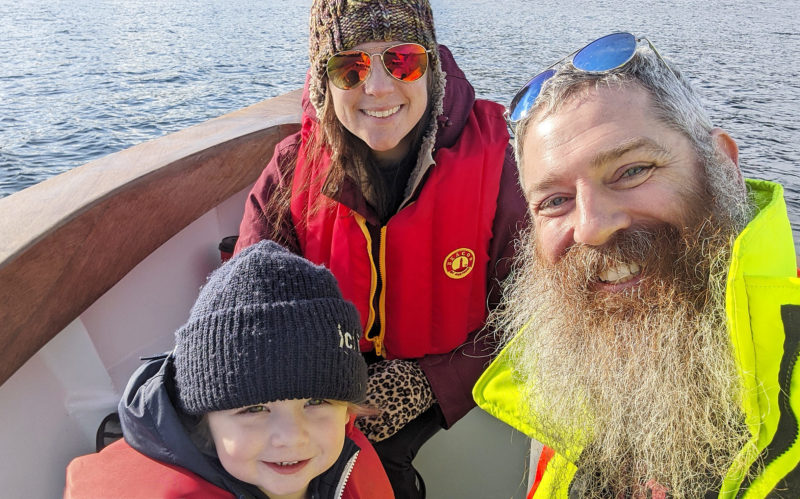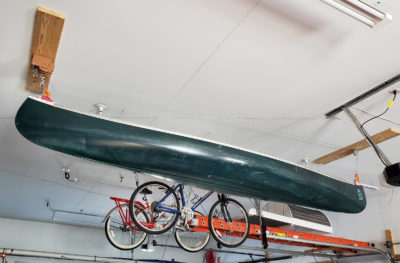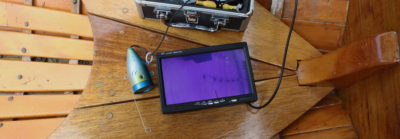Geordie Pickard’s dream boat began in mid-2020 with a sketch and culminated in June 2021 with a launching.
The Pickard family lives on Vancouver Island in British Columbia which is where Geordie grew up. They also own a cabin on the tiny, off-grid Ruxton Island, one of the Gulf Islands north of Victoria. For much of 2019, Geordie and his wife, Erin, lived on Ruxton and commuted back and forth to Duncan on Vancouver Island. At the time, says Geordie, they owned a “big heavy production boat with an I/O engine. It was built to handle Georgia Strait and was unnecessarily big for the shorter, more sheltered run to Vancouver Island. And the gas we used on the daily commute was killing me.”
 Photographs courtesy of the Pickard family
Photographs courtesy of the Pickard familyThe original sketch shows the wide open cockpit but also a pilothouse; the boat was launched without it, but Geordie plans to build one over the winter. The removable pilothouse will have molded-rubber cooler latches to make it easy to put on and off the boat.
Just before their son, Alaric, was born, Geordie and Erin moved off Ruxton to Vancouver Island, and it was then that Geordie decided to build a boat that was more efficient and purpose-designed for their needs. They were no longer commuting on a regular basis, but they still liked to get out on the water as much as possible.

With a background in technology, Geordie made full use of CAD software. Being able to see a computerized 3-D image of the boat from all angles was key in his design process.
“I really wanted an open boat with a large cockpit. I grew up drift-fishing with my dad, who’s a fanatical fisherman. He hated noise, so we’d motor to a spot, shut down, and cast homemade jigs for salmon or lingcod or greenling. I still mostly fish that way, and I got tired of having a boat that was enclosed and needed 200-plus hp to move. I wanted something that had a ton of cockpit space, would run with a small motor and plane at low speeds. Plus, I enjoy building boats.”

Geordie tested the integrity of the scarf joint over the deck railing just outside.Unable to lay out two joined plywood sheets end-to-end anywhere else, Geordie plotted the hull side panels on the bedroom floor, taking the offsets from his laptop.
In earlier years Geordie had built a couple of boats, including a “sailing skiff of my own design when I was about 20 and wanted to learn to sail.” He began a search for the perfect skiff design. At one point he considered building the Marissa 18 from B&B Yacht Designs, but Erin pointed out that Geordie had spent so much time researching boat design he could “probably do a decent job” himself.

The size of the boat was determined by the size of the garage. There was not an inch to spare and juggling boatbuilding with everyday living was not always easy. When it came time to fair the hull, everything, including the motorbike, acquired a fine layer of dust.
“That really got me thinking,” he says. “I don’t have any formal training in naval architecture, but I was pretty confident I could handle any math that came up. Honestly, I think a lot of people overthink it. I’ve spent enough time on similar-sized boats that I felt I had a good handle on realistic scantlings, so I just went for it.”

Geordie built the jig on a rolling platform so that the boat could be moved in and out of the garage with relative ease while remaining fully supported. Only when the boat was moved outside could Geordie stand away to see the hull from all angles.
Geordie designed an open 17′ by 6′6″ skiff that would be built of stitch-and-glue plywood with bright-finished mahogany trim. He says she’s “just a simple low-speed planing skiff with a shallow V and a sharp entry to ‘mush’ through the waves.” He designed her with no internal obstructions. “Even the ‘console’ is just a pole—enough for me to hold on to. It’s stepped through a threaded fuel fill onto a block so I can pull it out if I ever need more uninterrupted deck space, like when I’m carrying plywood sheets out to the island.”

Installing the outboard bracket. The boat’s chines have an almost unnoticeable downward angle along their length so that they act as very slight permanent trim tabs helping the boat to get up on plane at relatively low speeds.
The shallow hull was influenced by his earlier experiences in the “commuter boat.” That had a deep V and Geordie found it horribly uncomfortable when drifting in any sea. “It just rolled and rolled.” He wanted the new boat to be light and stiff, but also didn’t want it to slam into the waves at speed, so he compromised with a deep forefoot and a shallow V. He also angled the chines along their entire length so that they act “like very slight permanent tabs. It means the boat planes at extremely low speeds and gets up on plane smoothly…there’s no dead zone that you have to climb out of, it’s an almost unnoticeable transition.”
Geordie built the boat in his garage—the 17′ length was predetermined by the need to fit the project into the available workspace—using marine plywood ’glassed on both sides. “Even the underside of the cockpit sole is ’glassed. It’s overkill, but I wanted strength. Essentially, the plywood is core material, and the ’glass does 99 percent of the structural work. Even the stem is mostly unnecessary structurally, but we get so many logs in the water around here I wanted a semi-sacrificial ram to bull stuff out of the way. Sometimes we have to do that just to get into the bay at the cabin.”

Alaric and YEAH BUOY grew together. The built-in seat in the bow provides not only a great place to sit, but also buoyancy and storage. In front of it, tucked under the foredeck, is the anchor locker.
It took Geordie a year from initial sketch to “laying down the nonskid.” He wanted to get it done quickly so it wouldn’t “take time away from my kid once he was old enough to care.” By the time launching day came around Alaric was about 18 months old and “now we get to play with it together. Erin was really supportive. We have the cabin, and she likes to fish as well, so she’s pretty tolerant of my boat obsessions. I cut the long panels in our bedroom because it has the largest floor area. And I could test the scarfs by laying the panels on the deck railing outside and letting them bounce on the joint. It was a great way to test them, but more importantly, I have a wife who thinks cutting wood for a boat in our bedroom is reasonable, and more of a priority than replacing the ugly deck railing.”

Father and son fishing. The boat’s inherent stability makes for a safe platform and Geordie often steers standing up, holding the outboard’s tiller extension in one hand and the “console“ post in the other. The post is stepped through a threaded fuel fill in the cockpit sole so that it can be easily removed if uninterrupted space is needed in the cockpit when transporting bulky cargo to the island.
YEAH BUOY was launched in June 2021 (although Geordie would continue working on her for another four or five months). Her finished weight came in at a little under 700 lbs including the outboard motor. She will “just kiss 25 knots if lightly loaded and will cruise at around 18 knots with all of us on board.”

Having grown up drift-fishing with his father, Geordie knew he wanted a stable boat with a wide open cockpit. The gunwales became side decks—wide enough to provide a good leaning stage when landing a catch, and also to provide extra safety for the youngest crew member.
In the first year, Geordie says, he’s put about 200 hours on her. “Well, more really, because I drift-fish, so I shut the engine off a lot of the time, but there are about 200 hours on the motor.”

The seat in the bow has become a favorite spot for Erin and Alaric. The cockpit coaming is perfectly angled for use as a backrest and the frames provide some short-term storage for those all-important boat snacks and drinks.
The high bow, he says, makes for “a pretty dry boat, even in rough weather. I’ve had her out in sustained 15- to 20-knot winds, and it’s not bad. You can’t rip through the waves like you could on a big heavy boat with a deep V, but you can plane easily at low speeds and stay in contact with the water. So, it’s a better ride in lots of conditions because we’re not stuck choosing between the lolling 8 knots or brutal pounding at 20 that we faced with the old boat. Now, I can run at 12 or 14 knots in 2′ to 3′ seas and never drop off a wave. We just glide along.”

Geordie, Erin, and Alaric in the bow of YEAH BUOY.
In the works is a design for a removable pilothouse for rainy weather. It will, says Geordie, pop on and off with a “few of those whale-tail closures, like they put on expensive coolers these days.” But for their first two summers, the Pickard family had fun, fishing, drifting, and flying across the Sound, using YEAH BUOY as a tiller-steered open boat with a “cockpit sole the size of a dance floor.”![]()
Jenny Bennett is the managing editor of Small Boats Magazine.
Do you have a boat with an interesting story? Please email us. We’d like to hear about it and share it with other Small Boats Magazine readers.












Good morning.
What type of plywood did you use and in what dimensions?
Are you sharing the plans?
Now I have to go remeasure my garage, LOL. Very clean boat. I am on the Sound as well. Finishing up fixing an old fiberglass kayak for now but will probably do something like this in a few years when my kid can help.
More articles like this please. Doable boats on reasonable budgets. It’s nice to look at the fancy ones but getting on the water this is the way.
The hull was 1/4″ meranti; the sole was 3/8″. I don’t really have complete plans, I just drew hull panels for 4×8 sheets (some scarfed together as described) and made some of the details up as I went – this may be the case for most boats, though.
I don’t have a specific means by which to distribute the information I do have; if there’s interest though I’d look into publishing an e-book or something that includes the panel dimensions and explains the process. I’m not looking to profit off it or anything, I just don’t want a ton of people seeing “free boat plans” and then emailing me a million times because they want a free boat and have no experience building, and this is now somehow my responsibility.
Anyway I would happily share the plans, such as they are. I’d love if if there were more than one out there. Anyone truly interested in building the boat is more than welcome to the information I have. Just leave a reply to this comment.
I would be interested. She’s a beauty! I typically work from a table of offsets but would adapt to whatever you were willing to share.
I would be willing to send a few dollars for the time you would have invested in your ebook as well if you decide to pursue it.
Geordie, really nice little skiff you’ve put together. I’ve been thinking about a similar design. The removable cabin idea seems ideal for our weather out here. My shop is full at the moment, but I would interested in helping put together some plans in the future. I am shipwright/boatbuilder based in Seattle and would love to see more of these on the water.
Simple, clean and attractive. Well done!
Hi from NZ. Very nice build. What size outboard power are you using please?
The motor is a 25-hp Evinrude, early 1980s.
Christopher Cunningham, Editor
Great! One of the most simple, high power-to-weight-ratio, reliable outboards ever made!
Nice looking boat, and the family smiles tell how satisfied they are with it.
That’s a very attractive but obviously sturdy skiff. It would be ideal for cod jigging here in Newfoundland.
Great looking boat! Do you mind if I ask, what’s the software being used in the images?
Thanks,
C
Mid-Coast Maine
Would love to discuss the boat plans with you as she would be ideal for Nova Scotia waters. Nice design.
Chris
Would also pay for a set of plans, should they become available
In 2014, at age 68, a friend and I built one of Chesapeake Light Craft’s Peeler Skiff kits for many of the same reasons Geordie Pickard built YEAH BUOY. The resulting flat-bottomed skiff is hands-down, and dollar for dollar, the best investment in a boat I’ve made in a very long career as a boat owner.
Nine years later, she has proven to be an excellent family boat and still spends her summers on Rhode Island’s Narragansett Bay paying back the low cost of building, operating, and maintaining her with more fun per dollar than the long lost of more expensive boats I’ve owned.
How about the cabin/pilot house? I built a Point Comfort 18 and I’ve fantasized about adding a pilot house.
Cheers,
Steve